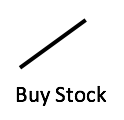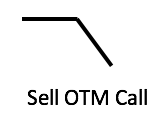
DESCRIPTION
The covered call is one of the most basic income strategies. But it is so effective that it is used by novices and experts alike. Basically, you own the stock and then sell out of the money calls every month. In this way, you land up collecting rent on the stock that you own. If the stock rises above the call strike, you get exercised. But since you own the stock, you simply sell the stock and keep the premium from selling the call. If the stock rises or stays where it is, you are better off because you collected the stock premium that adds to your overall profitability. I always think of this strategy as owning a piece of real estate and then renting it out. If you do it right, you can collect rent all year round.ITM | In-the-money | Stock price < Call strike price |
ATM | At-the money | Stock price = Call strike price |
OTM | Out-of-the-money | Stock price > Call strike price |
 +
+ 
- Buy (or own) the stock
- Sell out-of-the-money calls
- You will need to buy as many units of the stocks as the lot size of the options contract
- Only sell the calls on a monthly basis. Remember, while selling (writing) options, time decay is on your side. If done right, you can keep collecting premiums every month.
- Your maximum gain is capped when the stock price reaches the call strike price
RATIONALE
- To buy or own stock for the medium or long term with the intention to collect monthly income by selling calls every month. This is like collecting rent every month and will have the effect of lowering your cost base or better still creating an income stream for you.
- If the stock rises, you may be exercised. In which case, you will sell your stock (mostly for a profit) and keep the premium you received.
- If the stock falls, your sold calls will expire worthless and you will keep the premium you received.
ADVANTAGES
- Generate monthly income
- Lower risk than simply owning the stock
- Profit from rangebound stock
DISADVANTAGES
- Seasoned options traders will consider this an expensive strategy. This is because you can create a similar position by buying a very far month future or call option instead of the stock.
- Capped upside if the stock rises
- Uncapped downside. The only cushion is the premium you receive.
EXITING THE POSITION
- If the share rises above your strike price, you will be exercised and therefore make a profit
- If the share price remains below the strike price, you will earn an income via the premium
- If the share price plummets, you should buy back the options you sold and consider selling the stock as well
MITIGATING A LOSS
- Either sell the share or sell the share and buy back the option
Cost | Stock price – call premium |
Maximum Risk | Strike Price – call premium |
Maximum Reward | Limited to the call premium received plus the strike price minus the stock price |
Break-even | Strike price – Call Premium received |
Margin Required | Call premium plus cost of stock |
Effects of Time decay | For this trade, time decay is your friend. Especially in the week running up to expiry. You want the option you sold to approach zero. |
Effects of Volatility | After you are in the trade, you want the volatility to decrease. This will decrease the price of the call you sold. So, if you choose to close your position before expiration, it will be cheaper to buy it back. |
EXPERT TIP
- If you consider this strategy for creating a monthly income (like we do), you will need to create a trading plan that considers all possible scenarios:
- If the stock price rises above the strike price
- If the stock price falls a little but not below the acquisition price
- If the stock price falls below the acquisition price

